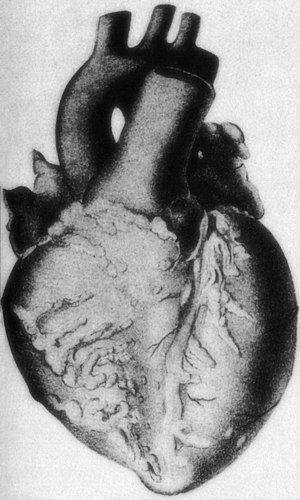Polyarteritis nodosa
| Polyarteritis nodosa | |
|---|---|
 |
|
| Polyarteritis nodosa: Macroscopic specimen of the heart with abundant adipose tissue and nodular thickened coronary vessels | |
| Classification and external resources | |
| Specialty | rheumatology |
| ICD-10 | M30.0 |
| ICD-9-CM | 446.0 |
| DiseasesDB | 10220 |
| MedlinePlus | 001438 |
| MeSH | D010488 |
Polyarteritis nodosa, also known as panarteritis nodosa,periarteritis nodosa,Kussmaul disease, Kussmaul-Maier disease or PAN, is a systemic vasculitis of small- or medium-sized muscular arteries, typically involving renal and visceral vessels but sparing the pulmonary circulation. Polyarteritis nodosa may present in infants. In polyarteritis nodosa, small aneurysms are strung like the beads of a rosary, therefore making "rosary sign" an important diagnostic feature of the vasculitis.
With treatment, five-year survival is 80%; without treatment, five-year survival is 13%. Death is often a consequence of kidney failure, myocardial infarction, or stroke.
In this disease, symptoms result from ischemic damage to affected organs, often the skin, heart, kidneys, and nervous system. Generalised symptoms include fever, fatigue, weakness, loss of appetite, and weight loss. Muscle and joint aches are common. The skin may show rashes, swelling, ulcers, and lumps. Palpable purpura and livedo reticularis can occur in some patients.
Nerve involvement may cause sensory changes with numbness, pain, burning, and weakness (peripheral neuropathy). Central nervous system involvement may cause strokes or seizures. Kidney involvement can produce varying degrees of kidney failure, such as hypertension, edema, oliguria, and uremia. Involvement of the arteries of the heart may cause a heart attack, heart failure, and inflammation of the sac around the heart (pericarditis).
There is no association with ANCA, but about 30% of people with PAN have chronic hepatitis B and deposits containing HBsAg-HBsAb complexes in affected vessels, indicating an immune complex–mediated cause in that subset. The cause remains unknown in the remaining cases; there may be causal and clinical distinctions between classic idiopathic PAN, the cutaneous forms of PAN, and the PAN associated with chronic hepatitis.
...
Wikipedia
